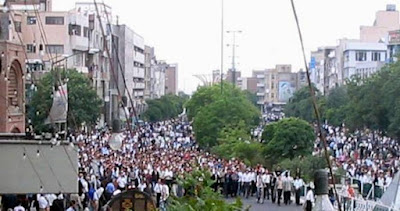Fakhteh Zamani - May, 2006
 |
Hundreds of demonstrators started to protest in front of “Rasteh kucheh” and the Bazaar of Tabriz and moved towards Eastern Azerbaijan’s governor’s office. At the same time, in another part of the city, students of Tabriz University began peaceful demonstrations by asking for fundamental human rights for the Azerbaijani nation. Many onlookers joined in while moving from the University towards the governor’s house. Special Forces and the police blocked the university movement and did not let the groups unite. By the time the “Rasteh kucheh” group had reached the governor’s office, their numbers had increased several times.
The protesters shouted slogans such as: “Down with Chauvinism!”, “Azerbaijani nation will not bow to such abasements!”, “When North and South Azerbaijan unite, Tabriz will be its center!” [Translator’s Note: “Northern Azerbaijan” is the Republic of Azerbaijan which is located in the north of Araz river and “South Azerbaijan” lies in Northwestern Iran, south of Araz River], “Death or Independence!”, “Coward governor, come and answer to this!”, “Iran newspaper has to be closed!” and “Sattar khan, Bagher khan, your sons have all been awakened!” [Translator’s Note: Sattar khan and Bagher khan are two Azerbaijani Freedom heroes who fought for democracy and freedom in the “Constitutional Revolution.” They were honoured by the title of "Sardar-e Melli" (National General) and "Salar -e- Melli" (National Leader), respectively by the order of the Assembly.] None of the governor’s officials appeared in front of the protestors. Meanwhile, under police attack, the demonstration’s path changed to “Bank -e- Melli” (National bank) and Amin’s T-section (name of the street). Interference by fire trucks and the attack of the police using tear gas caused chaos among the protestors. The tear gas had caused people to run from the governor’s office. Some of them started throwing stones at the government building, resulting in increased force from the police. Police pursuit forced demonstrators to move toward Shariati Avenue.
Confronting a massive crowd of people, the officers from Police Station #12 retreated inside the building, which allowed people to go on.
Demonstrators reaffirmed their slogans and, without any violence, continued moving towards Tabriz University, passing through Clock Tower Square, Mansour crossway and Abresan crossway.
Special Forces and Revolutionary Guards continued to repress the movement by stopping and arresting those filming and photographing. Some shootings had been heard around Tabriz University. Forty-eight people have been reported injured. Some unconfirmed sources talk of six people killed. Approximately 187 demonstrators were reported to have been arrested. Some of the injured at the Behbood hospital (police hospital) are under arrest, and three are injured because of gun shootings.
The number of demonstrators is estimated to be between 200 and 300 thousand. This is the largest protest of Azerbaijanis against the violation of their human rights since 1979. Like all other governmental newspapers, the newspaper must have its content thoroughly checked and approved by the Iranian government before publication. This is not the first time a cartoon of this nature has been published, which has infuriated University students in Azeri cities in Iran, and has raised protests and hunger strikes in Tabriz, Urmia, Tehran, Ardebil, Maragheh and Zanjan Universities.
Students have not forgotten the racist survey distributed by the Islamic Republic of Iran Broadcasting (IRIB) in 1995 that insulted Azeri Turks.
Students have also seen their mother language ridiculed in movies and soap operas broadcast by a single TV outlet which is government monopolized. Today, “Persian” is the only official language in Iran, even though articles #15 and #19 of the constitution specify that education and the development of the culture and language of other ethnic groups are guaranteed. This article has never been implemented towards Azeri-Turks and other minorities in Iran.
Azerbaijanis (or Azerbaijani Turks) are Iran's largest ethnic “minority” group.
Of Iran's sixty million total population, the Azerbaijani Turk nation comprises over 30 million people, mainly in Western and Eastern Azerbaijan, Ardebil and Zanjan provinces.
As a comparison, the population of the neighbouring Republic of Azerbaijan (north of Iran) is eight million. During the last few decades, Azerbaijani Turks in Iran have been subjected to humiliation under the chauvinistic rules of the Shah and the Islamic Republic.




